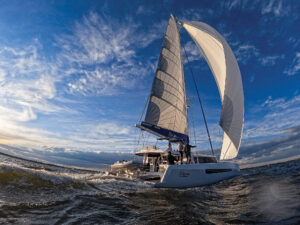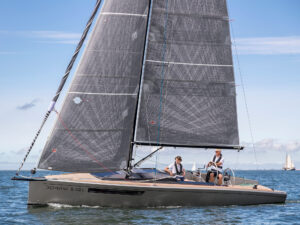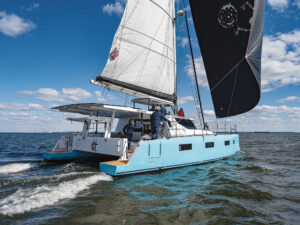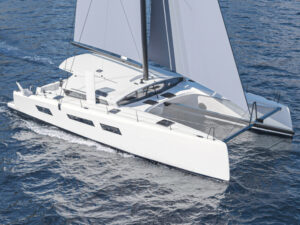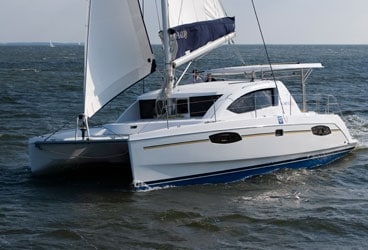
Leopard 38 368 winner
Nascar has the Daytona 500. The N.F.L. has the Super Bowl. Racing sailors have the America’s Cup and the Volvo Ocean Race. But for anyone interested in the newest cruising boats launched in any given year, there’s only one place to be on Columbus Day weekend: the U.S. Sailboat Show in Annapolis, Maryland.
Now, I’m not saying that Cruising World’s 17th annual Boat of the Year Awards judging program is the World Series of water sports or the Stanley Cup of sailboat tests, but I will say that when the cannon was fired to signal the start of the Annapolis show, it was quite apparent that the boatbuilders and designers had come to play. And so did our BOTY panel of industry experts. If you’ve visited the show in the past, you may have seen them in action. They’re the ones wearing lots of Cruising World swag, clutching notebooks, and sticking their noses into every nook and cranny of all the new boats tied to the docks. And when the show breaks up, they begin jumping from test sail to test sail on the waters off Annapolis like some kind of amphibious assault team.
The truth is, the BOTY program is more like a marathon than anything else. In fact, the process of getting acquainted with all the new models that we’d consider for this year’s BOTY awards got started at the Newport International Boat Show in September. It was there that we got our first glimpse of the boats that the judges would be poking, prodding, and putting through their paces-in conditions that ranged from light zephyrs to driving rain and 25-knot winds-in the coming weeks. We soon realized that this wasn’t going to be the year of radical risk taking. Unlike past years, when some boat designs pushed deep into uncharted waters, this year’s debuts, with only a couple of exceptions, represent design evolution rather than reinvention. But that’s not a bad thing. New launches from such production builders as Catalina, Island Packet, Hunter, and Beneteau, among others, show that boatbuilders are working hard to deliver what sailors want, and they’ve listened to plenty of owner feedback to make sure that they do.
This approach to boatbuilding was evident in every BOTY category; these categories came together based on the dockside visits that our preliminary-round judges paid during the Newport show and before things got started in Annapolis. This year, the preliminary team included CW editor Mark Pillsbury, BOTY veteran and CW editor at large Tim Murphy, and me.
And it was especially apparent (though exemplified in different ways) in the Multihull Cruisers category. Did I say Multihull Cruisers? First off, it was refreshing to see a few more two-hulled boats this year. Unlike last year, when only one new cruising catamaran was launched, four new models-a Lagoon, a Fountaine Pajot, and two from Robertson and Caine-made their debuts this year.
The Lagoon 400 is one of those design exceptions referred to earlier. Potential owners said they want cruising-cat accommodations to be closer to those you have in your house, and the designers delivered just that. As a result, the 400’s hulls are wide, and they have the freeboard required to contain truly spacious living spaces-and generous bridgedeck clearance-in a 40-foot package. During their dockside visit, the judges found the design team of Marc Van Peteghem/Vincent Lauriot Prévost made no attempt to mask the height of the hulls with steps in the hull or deck. As a result, the boat had the most radical look of all the cats we tested. Still, we found that the deck is wide, flat, and easy to navigate and that the living space within was indeed impressive.
Fountaine Pajot’s Lipari 41, on the other hand, represents the evolution of thought from a builder that’s been producing cruising cats for more than 25 years. It has the distinctive bridgedeck saloon windows and French styling for which the company is known, and the judges were impressed with the way it performed in the 25 knots of breeze we had during the sailing trials. Even in the cold rain, they were still smiling thanks to boat speeds of 9 knots or better.
While the other cat builders had the benefit of owner feedback, Robertson and Caine, the builders of the Leopard 38 and the Sunsail 384 (the former available privately with an owner’s cabin to starboard, the latter built for Sunsail with four cabins and equipped specifically for charter) had the added benefit of knowing what works-and doesn’t-thanks to the legions who opt to sample cats while on charter. As a result of the collaboration between Sunsail, the South African builder, and designers Morrelli & Melvin, both models impressed the judges with strong construction, excellent systems installations, clever design solutions, and peppy sailing performance. And the well-executed details-such as the elegantly simple and powerful electric davit system, the singlehander-friendly helm station, the little lip on the stairs descending down into the hulls, and the wide platform on the sterns to make boarding from a dinghy easy-really kept the judges buzzing. After much debate (involving the other cats as well as the Sunsail version), the judges named the Leopard 38, with its more owner-specific focus, the Best Multihull Cruiser as well as the Import Boat of the Year. You’ll find more details on all the winners as well as write-ups on all the nominees as you read on.
Of all the groupings, the category of Premium Cruisers Over 50 Feet was particularly tough to narrow down, simply because each of these boats is built to high standards and carries a price tag that would indicate craftsmanship and performance. The Tayana Annapolis 64 and the Passport Vista 615 had the “benefit” of being test-sailed in 25 knots of wind and rain-conditions a prospective owner is sure to encounter on the long offshore passages for which these vessels are made. Both handled the nasty elements beautifully. The Tayana had a big, comfortable cockpit; excellent visibility from its dual helm stations; decks free of clutter, since all lines run back to the cockpit through races under the deck; and a hull with more than enough muscle to stand up to the stiff breeze. The accommodations plan was filled with interesting features, including an accordion door that turns the big guest cabin forward into two separate cabins when it’s opened.
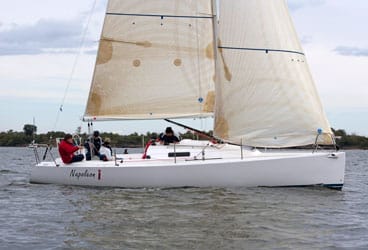
Billy Black
The J/95 was named the Domestic Boat of the Year and the Best Weekender.
Meanwhile, the reefed-down Passport easily reeled off speeds in the 9’s. The accommodations plan was bright and airy, the joinery was top notch, and during the judges’ deliberations, the Passport’s engine room elicited high praise from systems expert Roger Hellyar-Brook. “That boat has one of the best engine rooms I’ve seen,” he said.
The Morris M52, billed as the company’s flagship “daysailer,” may have been test-sailed in slightly more sedate conditions, but it still provided the judges with more than a few reasons to like what they saw. In the end, the M52’s superior sailing performance, impeccable craftsmanship, and well-executed deck plan and anchoring system had all of the judges wishing our test sail hadn’t ended. Still, since the judges are asked to assess the boat they’ve sailed, the lack of lifelines-a trademark look of the daysailer genre-caused them to pause when considering this boat as a bluewater cruiser. But then they concluded that the M52 was too good to leave the show empty-handed. So they dusted off the Bristol Award, a prize that in the past has gone to the most drop-dead gorgeous boat displaying the finest craftsmanship at the show. Can’t argue with that.
Meanwhile, all of our judges-who, as a group, have sailed thousands of offshore miles-were unequivocal in their praise for the purposeful quality and simplicity of the Oyster 655. It got the nod as the Best Premium Cruiser Over 50 Feet.
It may be a sign of the times, but the category that’s historically been one of the biggest and the scene of the most hotly contested award-Full-Size Cruisers, 40 to 50 Feet-was composed of only three boats. But that didn’t make it any easier for our judges to pick a winner. The Hunter 50CC is similar to the Lagoon in that it was touted as a liveaboard cruiser that can provide the comforts of home, and Hunter hit the mark there. From the walk-in closet (yes, a complete walk-in closet with a full-length mirror, just like you have at home) in the master cabin aft to the electric-powered invection burners (all the rage in home-kitchen remolding right now) to the tile in the shower stalls, the accommodations plan is designed for homey luxury.
In a way, the Beneteau First 40 couldn’t have been more different. Farr Yacht Design created this boat specifically to be a racer/cruiser. It’s got an open transom that can be somewhat closed off with a thin, removable fiberglass beam. And like many raceboats, the cockpit seats aren’t designed to stretch out on, but they do provide deck storage and can be easily removed and left on the dock when it’s time to race. And oh, yeah: There’s no real deep keel sump. Getting all the water out of the shallow bilge involves pulling up the floorboards and inserting the long bilge-pump hose into each separate grid (just like a raceboat). The judges loved how easily driven this stiff boat was under sail. It stood up to its canvas (laminated sails with Kevlar yarns), and the unanimous verdict among the judges was that it was simply a blast under way. And it has many of the features-comfortable bunks, working galley, enclosed head, decent stowage-that you need to cruise in comfort, too.
The debate stirred up in determining the award in this category was one of the longer and more philosophical ones that the judges had. But in the end, the Catalina 445 was named the Best Full-Size Cruiser, 40 to 50 Feet because designer Gerry Douglas’ attention to detail and well-executed ideas came together to form a truly comfortable and capable cruising boat.
The entries in the category of Midsize Cruisers Under 40 Feet came from three well-known builders, and every design shows that each builder is sticking to its strengths in these uncertain times.
The J/97 comes from a company, J/Boats Inc., that strives to build slippery, fast boats that are as at home on a racecourse as they are on a coastal cruise. And both racers and cruisers will likely appreciate the tactile feedback of the tiller steering, the ease and speed potential of the asymmetric spinnaker that sets on a retractable sprit, and the stability and narrow upwind tacking angles that a deep (6-foot-4-inch) bulb keel makes possible. The accommodations layout is pretty conventional, but one cool thing about this boat is that some storage cabinets have been replaced by clever bags hanging on wires along the hull. They’re light, totally functional, and can be removed when you need a backpack on land. Brilliant!
Hunter Marine has a well-earned reputation for comfortable accommodations, and the Hunter 39 is no exception. The saloon settee earned high marks from the judges, who also noted that the cabins have large bunks and that the cockpit seats are big enough for stretching out on. New window styling in the cabin top and flush-mounted hatches on deck result in a bright and airy interior and give the overall lines of the boat a fresh look in comparison with previous models, an indication that the Hunter design philosophy continues to evolve.
Meanwhile, the Island Packet Estero is exactly what you’d expect from Island Packet. It’s a sturdy, full-keel cruiser that paradoxically shows that IP designer and founder Bob Johnson is also not constrained by conventional accommodations design. He put the saloon forward, where most V-berths are. This isn’t a revolutionary idea, but when the judges started tallying up all the things that this boat gets right-the comfortable accommodations plan was right up there with the Estero’s quality construction, stability, and the fact that the boat will look after owners when the weather gets nasty-it was the Estero that they named as the Best Midsize Cruiser Under 40 Feet.
How would you like to spend your weekend? Well, you’d have some choices if you were interested in any of the entries in the Weekenders category, where each of the boats was designed to be fun to sail and provide decent overnight accommodations on a short coastal cruise. The judges found that each entry accomplished those goals in very different ways. The one similarity was that all the boats in this category have some sort of galley, head, and sleeping berths, and all can be overnighted as long as you don’t mind basic crusing comforts.
The Corsair Dash 750 is a trailerable trimaran that had the judges absolutely beaming at its ability to sail at close to 14 knots in about 12 to 14 knots of breeze. That’s something the other boats in this category simply can’t claim. The Dash also has an accommodations plan that provides several sleeping bunks and camping/cruising capability.
Then we have the M29 from Morris Yachts. It’s the kid sister to the M36 and the other M Series boats that have helped to define the daysailer genre. As a result, it has the classic looks, luscious overhangs, and quality craftsmanship you’d expect, along with more racy features-like a spinnaker launcher/retriever at the bow-that makes it easy to fly the kite.
Next up is the Sensei 9M, which provides a Euro-styled alternative to the American daysailer aesthetic exemplified by the Morris. The sleek Sensei may look like a raceboat, but it’s designed specifically for daysailing and an occasional overnight. The judges were as impressed with its construction as they were with the boat’s looks and sailing performance.
But what really put twinkles in the judges’ eyes was the way the J/95 accomplished its stated design brief. During our dockside visit, designer Rod Johnstone told us that he wanted to build a comfortable coastal cruiser that could keep people sailing by providing “high performance in shallow water,” and the J/95 did exactly what Rod said it would. In the end, the judges found lots more reasons to sit up and take notice, naming the J/95 not only the Best Weekender but also the Domestic Boat of the Year.
In a year that had us wondering just what we’d see in Annapolis, the judges came away impressed with the choices.
To read about the winners follow these links:
Leopard 38: Best Import Boat of the Year
J/95: Best Domestic Boat of the Year and Best Weekender
Island Packet Estero: Best Mid Size Cruiser Under 40 Feet
Catalina 445: Best Full-Size Cruiser, 40 to 50 Feet
Oyster 655: Best Premum Cruiser Over 50 Feet
Morris M52: BOTY Judges’ Bristol Award
Bill Springer is CW’s senior editor and the director of the Boat of the Year awards program.

